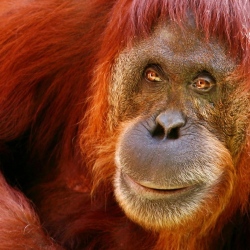
At TED 2013 Thursday, Diana Reiss, Peter Gabriel, Neil Gershenfeld, and Vint Cerf launched the idea of the “interspecies internet.”
Diana Reiss, a cognitive psychologist, has been been teaching dolphins to communicate through an underwater keyboard of symbols that correspond to whistles and playful activities.
Through this keyboard, the dolphins learned to perform activities on demand, and also to express their desire for them. (Also see Denise Herzing’s talk.)
“You can’t get more alien than the dolphin. We’re separated by 95 million years of divergent evolution. These are true non-terrestrials,” says Reiss. “This [is] self-organized learning, the same thing we heard from TED Prize winner Sugata Mitra.” (Mitra created the famous “hole in the wall” experiment in self-organized learning in India.)
Peter Gabriel shared a video (see video excerpt below) of a bonobo with a keyboard. This was the first time this bonobo had ever seen a keyboard. And with accompaniment, she played truly amazing music.
As KurzweilAI noted last April, Bonobos at Bonobo Hope Great Ape Trust Sanctuary (see notes under the Gabriel YouTube video) use touch displays to communicate with people. An iPad app to communicate with people via the Internet was proposed in a failed Kickstarter project.
Neil Gershenfeld, the Director of MIT’s Center for Bits and Atoms, video-conferenced in animals live — including orangutans in Waco, Texas, dolphins at the National Aquarium in Baltimore, and elephants in Thailand.
Gershenfeld is known for his work in the internet of things. And he thinks animals can be a part of it, too. ”We’re starting to think about how you integrate the rest of the biomass of the planet into the Internet,” he says.
